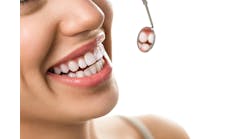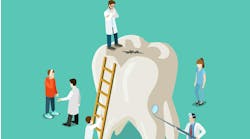By Ali Kanawati, DDS, MBA, MS
For more on this topic, go to www.dentaleconomics.com and search using the following key words: implantMost industries aim to maximize profits subject to cost constraints. Profit maximization in any firm is achieved when that firm is able to reduce the cost of production and/or increase sales volume. Even though today’s economy is improving, increasing the volume of sales is a challenge for most. This has prompted many clinicians to explore alternative methods to lower their cost of production. The current markets have shifted to focusing more on being price oriented, and in some cases less quality sensitive. One way clinicians are attempting to cut costs is in the field of implant dentistry.
First and foremost, I believe that there is a place in the market for both brand name implant fixtures and the generic implant fixtures frequently produced by more start-up companies. A parallel would be the prescription drug market, which has both generic and brand name drugs.
Both have their market share, and both have physicians who prescribe them for different reasons. However, many studies have cited possible absorption rate differences between same doses of generic versus original medications. Ultimately the patient absorbs the majority of the medication, generic or not, and hopefully receives some therapy from whatever is absorbed.
I believe it’s healthy to have an alternate and less costly option for patients. This reminds me of the debate between amalgam and composites. Amalgams are not without controversy, but they still offer a truly low cost and sometimes long-lasting restorative result. Generic implants carry some controversy, such as a patent squabble here and there, and generally lack the service support and long-term data.
One main concern is that in 15 years we may have some restorations to remake on implants from companies that shut down 10 years ago, along with their support. One thing that makes me feel comfortable working with original companies is that the statistical chances of them shutting down are almost negligible.
Mixing and matching
Another concern is mixing and matching generic restorative components with brand name implant fixtures. My concern is not with generic implant companies that manufacture their own restorative components. If a dentist wishes to use a generic implant company, that is a decision that he or she makes based on different criteria.
One criterion is the amount of representative support with brand name companies compared to little if any support provided by generics. Another condition affecting a decision is the pledge by the brand name companies to stand behind their products and replace them at minimal if any cost if they fail, while most of the generics have no such pledge. Finally, it’s what type of practice the dentist is interested in maintaining.
The practice of mixing and matching dental implant components to implant fixtures of different manufacturers is unfortunately becoming more common. The issue is not using generic implant fixtures, but there is a concern regarding mixing components of one company to fit into another company’s patented connection.
We all know that to get around patents, the item of concern has to be made differently than originally designed. Unfortunately, that means the restorative component has different connection integrity than its original counterpart.
When an implant is designed, engineers design its components at the same time to achieve the best possible long-term connection performance. Anything after market in this situation is inferior because due to patents, the exact same component cannot be designed and manufactured.
These components have an alternate fit. The increased supply of nonoriginal retrofit aftermarket components has many risks and will incur costs for everyone in the future.
The brand name companies take pride in the research and development that went into engineering their implants. Each company is proud to discuss benefits of its system.
The benefits ultimately increase the long-term stability of the entire system (implant fixture and restorative components), therefore decreasing the potential for complications. These benefits are not available when generic restorative components are mixed with brand name implants.
One quick example to get my point across is the Zimmer Hex-Lock® connection with the one degree taper. This is a patented feature of the Zimmer system, and according to the manufacturer it significantly decreases the potential for abutment loosening after final torque.
Any other generic component that “fits” into that connection does not have that feature, therefore potentially increasing the likelihood of the abutment loosening after the restoration is put into function.
Raising ethical issues
An ethical issue is that some labs are using aftermarket components and sending cases back to dentists without the dentists’ knowing the components are aftermarket. This is when using a reputable lab that assures the use of original components is recommended. I would like to touch upon the CAD/CAM abutments currently being fabricated by many companies.
If you prescribe a patient-specific custom-milled abutment, have your lab send that case to the original manufacturer, and they will include their patented connection within the abutment, as those patent rights are not released to other milling companies.
Most brand name implant companies have implemented some clause in their pledge to stand behind their products. That pledge is voided if the clinician uses aftermarket components on their implants.
What some in the dental community are doing by mixing and matching implant components is somewhat analogous to mixing Jet® monomer into Snap® powder.
The mixture will probably work, but with altered performance and different physical qualities of the polymerized acrylic. It’s understandable to do something like this when you’re in a “pickle” or an uncommon situation.
However, to open a catalog and order Jet monomer to go along with the Snap powder in your office just because the Jet liquid is cheaper than the Snap liquid may seem ludicrous by some.
When components do not fit onto implant fixtures consistently with the original design principles, and with altered screws that hold those components down, there will definitely be an increased potential for complications.
Minimizing complications
By minimizing the gross number of restorative complications, we increase positive patient response within the public, forging a positive public image perception of dental implants. If we knowingly use components that increase the chance of complications for our patients, we as a group risk tarnishing or destroying public perception of implant dentistry.
We have all recommended implant treatment to a patient who is adamant about not having implants because her neighbor had them and they were terrible because something broke, they weren’t comfortable, they caused pain, etc.
My concern for the future, especially with government getting larger, is that if the dental community does not govern itself relative to aftermarket dental implant components, there may be enough issues and complications to prompt nondental individuals to govern what we do.
It all comes down to informed consent to be fair to patients, as well as what level of dentistry one wants to practice. We all know we have choices with impression materials or composites or even what lab we use for our prosthetics, and some are less costly than others. The issue is more than cost. It’s the connection interface of components to each other.
Dr. Ali Kanawati grew up in southern West Virginia, and attended West Virginia University in Morgantown where he received his B.A. in biology and master’s in business administration with an MBA specialty in health-care administration. He received his DDS followed by a master’s degree in advanced prosthodontics from the WVU School of Dentistry. Contact him at [email protected].







